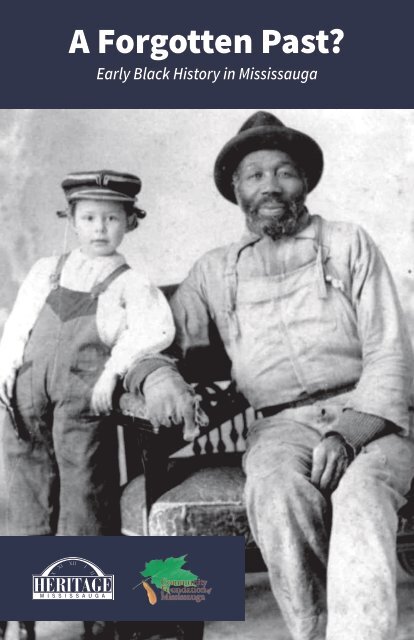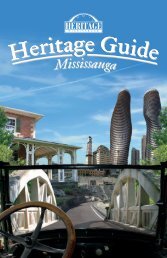A Forgotten Past: Early Black History in Mississauga
Create successful ePaper yourself
Turn your PDF publications into a flip-book with our unique Google optimized e-Paper software.
A <strong>Forgotten</strong> <strong>Past</strong>?<br />
<strong>Early</strong> <strong>Black</strong> <strong>History</strong> <strong>in</strong> <strong>Mississauga</strong>
Introduction<br />
With the abolition of slavery <strong>in</strong><br />
the British Empire on August 1,<br />
1834, the movement of former and<br />
fugitive slaves <strong>in</strong>to Canada began <strong>in</strong><br />
earnest. Canada was seen as a land<br />
of freedom and a place to start a new<br />
life. The grow<strong>in</strong>g abolitionist movement <strong>in</strong> the United States, the birth of the<br />
Anti-Slavery Society of Canada, and the development of the Underground<br />
Railroad aided the travel of <strong>Black</strong>s <strong>in</strong>to Canada.<br />
A few <strong>Black</strong> families came to live <strong>in</strong> historic <strong>Mississauga</strong> (formerly Toronto<br />
Township). Distance from the American border and relative geographic<br />
obscurity were <strong>in</strong>centives. Those that came <strong>in</strong>cluded <strong>Black</strong> Loyalists,<br />
emancipated former slaves, fugitive slaves and free <strong>Black</strong>s look<strong>in</strong>g for a new<br />
home and protection under British rule. There is very little tangible evidence<br />
of these historic connections. <strong>Early</strong> census records, council records, birth,<br />
marriage and death certificates provide a glimpse <strong>in</strong>to this part of our City’s<br />
past. Much of this story is sparsely documented, and photographs are few and<br />
far between. Some fugitive slaves, like Benedict Duncan, found their way to<br />
Canada via the Underground Railroad and developed some connections here,<br />
and <strong>in</strong> neighbour<strong>in</strong>g communities like Oakville. Elsewhere <strong>in</strong> the Prov<strong>in</strong>ce,<br />
predom<strong>in</strong>antly <strong>Black</strong> communities were established, such as the Wilberforce,<br />
Dawn, Oro and Buxton settlements.<br />
Front Cover: From the Purnell Collection, courtesy of the Archives of Ontario.<br />
Above: Act for the Abolition of Slavery <strong>in</strong> the British Colonies, August 28, 1833 (<strong>in</strong>to effect on August 1, 1834)<br />
Above: Unknown picture, possibly from Toronto Township,<br />
1<br />
Port Credit Scrapbook, <strong>Mississauga</strong> Library System.
Underground Railroad<br />
The Underground Railroad was a name given to an <strong>in</strong>formal network of secret<br />
routes, safe houses, and “conductors” (people) that focused on assist<strong>in</strong>g<br />
former and fugitive <strong>Black</strong> slaves to escape from the United States <strong>in</strong>to<br />
Canada, where many abolitionists were sympathetic to their plight. Houses<br />
and build<strong>in</strong>gs that offered safe refuge along the route were often lit with a<br />
solitary lantern <strong>in</strong> an attic w<strong>in</strong>dow dur<strong>in</strong>g the night as a signal.<br />
The Underground Railroad operated from about 1820 until 1865, and was at<br />
its height just prior to and dur<strong>in</strong>g the American Civil War. Estimates suggest<br />
that between 30,000 and 100,000 slaves escaped to Canada via the “Railroad”.<br />
The routes taken by slaves were varied, and harbours and actual railroads<br />
were often used. Local to historic <strong>Mississauga</strong>, for example, the harbour at<br />
neighbour<strong>in</strong>g Oakville was one term<strong>in</strong>us, while Orangeville was rumoured<br />
to be another. From these locations, escaped slaves often dispersed, settled<br />
nearby, or jo<strong>in</strong>ed established <strong>Black</strong> communities elsewhere <strong>in</strong> Southern Ontario.<br />
The Fugitive Slave Act of 1850 <strong>in</strong> the United States sought to stem the tide<br />
of those seek<strong>in</strong>g to escape slavery. Slave catchers, emboldened by the Act,<br />
were documented <strong>in</strong> Toronto, and <strong>in</strong> part led to ga<strong>in</strong><strong>in</strong>g support for the<br />
formation of the Anti-Slavery Society of Canada <strong>in</strong> 1850. At the same time,<br />
abolitionist newspapers such as The North Star, Voice of the Fugitive and the<br />
Prov<strong>in</strong>cial Freeman championed the abolitionist movement, published slave<br />
narratives, and promoted the freedom offered <strong>in</strong> Canada. Harriet Beecher<br />
Stowe’s novel, Uncle Tom’s Cab<strong>in</strong>, published <strong>in</strong> 1852, helped to propel the<br />
abolitionist movement.<br />
Above: Runaway Slaves, artwork from the Underground Railroad, from <strong>History</strong>.com<br />
2
Cedar Park Farm<br />
One of the best documented early <strong>Black</strong><br />
families <strong>in</strong> historic <strong>Mississauga</strong> was the Ross<br />
family of Cedar Park Farm. The Ross farm<br />
was located near the modern <strong>in</strong>tersection<br />
of Cawthra and Burnhamthorpe roads, and<br />
Rayfield Park is located on the former Ross<br />
farm. George Woodford Ross (c1796-1878) was an emancipated former slave from<br />
Urbanna, Virg<strong>in</strong>ia. His father and slave-owner was James Ross, a Scottish-born<br />
land-owner. It is difficult to come to terms with a relationship between a slaveowner<br />
and enslaved children. James Ross emancipated his children, of which three<br />
half-brothers came to Canada <strong>in</strong> the 1830s, adopt<strong>in</strong>g the Ross surname (George<br />
Woodford, William Woodford and Corb<strong>in</strong> Lane).<br />
“I, James Ross of Town of Urbanna <strong>in</strong> the County of Middlesex, consider<strong>in</strong>g that my mulatto<br />
slave, Mary Woodford (now deceased) and her daughter, Nancy Woodford, were the gifts of my<br />
two good friends, the late Clement Nicholson and Annie his wife as by their Deed recorded. DO<br />
EMANCIPATE and SET FREE all the children of the said Mary, to wit, Nancy Woodford, Frances<br />
Woodford, William Woodford, David Woodford, and George Woodford .”<br />
In James Ross’ will from 1825, the Cedar Park Farm plantation <strong>in</strong> Virg<strong>in</strong>ia was to<br />
be divided among the Woodford children. It is likely that the capital from this<br />
allowed George Woodford Ross to come to Canada and eventually purchase his<br />
own farm here <strong>in</strong> historic <strong>Mississauga</strong>.<br />
George’s wife was Didamia Paul, who had been a school teacher at the<br />
Wilberforce Settlement near what is now London, Ontario. Didamia’s father,<br />
Benjam<strong>in</strong> Paul, had helped to establish Wilberforce. George and Didamia were<br />
married <strong>in</strong> 1834, and <strong>in</strong> 1836 purchased a 200-acre farm <strong>in</strong> historic <strong>Mississauga</strong>.<br />
George and Didamia Ross had 11 children: Benjam<strong>in</strong> Paul (born 1836),<br />
Elizabeth Adelaide “Eliza” (c1840), Charles Warburton (1843), Kate Mytilene<br />
(1845), Corb<strong>in</strong> Levi (1847), Didemia Anne (1848), Celest<strong>in</strong>e Sarah “Cessa”<br />
(1850), James Woodford (1852), Rebecca Evangel<strong>in</strong>e “Eva” (1854), Alexander<br />
Campbell (1855) and Georg<strong>in</strong>a (1857). The family rema<strong>in</strong>ed <strong>in</strong> the community<br />
for several generations. Rebecca’s son, Private Wilfred Arthur W<strong>in</strong>stanley Cook<br />
of Cooksville, served and fell dur<strong>in</strong>g the First World War.<br />
3<br />
Above: Ross-Cook House, Cedar Park Farm, built circa 1836 by George Woodford Ross, brick<br />
veneer added circa 1870s, purchased by Henry Cook <strong>in</strong> 1919, demolished circa 1975.
Dur<strong>in</strong>g the time that Cedar Park Farm existed, Solomon<br />
Northup, author of Twelve Years a Slave, a memoir and<br />
slave narrative first published <strong>in</strong> 1853, visited Streetsville<br />
<strong>in</strong> August of 1857, where he was not warmly welcomed<br />
and a hostile reception prevented him from speak<strong>in</strong>g<br />
at the Town Hall. The Globe newspaper recounted the<br />
violent opposition he encountered. Hotel keeper, Robert<br />
Stephens, is credited with ensur<strong>in</strong>g Solomon’s safety.<br />
Others <strong>in</strong> this community were likely supporters of the<br />
Anti-Slavery Society of Canada, championed largely by Reform Politician George Brown<br />
of The Globe. These supporters <strong>in</strong>cluded the local Reform politician for Peel County,<br />
James Cox Aik<strong>in</strong>s and Charles Willcox, a well-to-do local farmer and friend of the Ross<br />
family. However, the <strong>in</strong>cident <strong>in</strong>volv<strong>in</strong>g Solomon Northup <strong>in</strong> Streetsville highlights that<br />
there rema<strong>in</strong>ed deep social divisions regard<strong>in</strong>g the treatment of <strong>Black</strong>s.<br />
Samuel Carter<br />
Solomon Northup<br />
Samuel Carter was a fugitive slave who arrived <strong>in</strong> Port Credit after 1861. As a result of<br />
his flight from slavery he lost both his legs due to the exposure to cold. Little is known<br />
of Samuel. In Port Credit Samuel was befriended by James Shaw (1811-1908), a wellknown<br />
and respected resident. James secured a horse for Samuel, along with a lift that<br />
allowed Samuel to get on a horse, and us<strong>in</strong>g the horse to pull a small wagon Samuel<br />
assisted <strong>in</strong> transport<strong>in</strong>g people to Sunday service at the First Methodist Church.<br />
Samuel lived <strong>in</strong> a small cab<strong>in</strong> near the Methodist Manse on a tree-l<strong>in</strong>ed dirt laneway that<br />
was locally known as “Old Sam’s Lane”. The lane was eventually widened, paved and<br />
renamed “Wesley Avenue”. Samuel was apparently well thought of <strong>in</strong> Port Credit. When<br />
he fell ill <strong>in</strong> the fall of 1887, town residents banded together to make sure he was looked<br />
after. On at least one occasion Port Credit Council made money available for Samuel,<br />
and <strong>in</strong> early 1888 Council passed this resolution:<br />
“Moved by Mr. Jackson, and seconded by Mr. Price that the Petition of B.B. Lynd and<br />
22 others be received and that Mr. Lynd and Mr. Oliphant be <strong>in</strong>structed to have Samuel<br />
Carter removed to some place of comfort and have his wants attended to for the<br />
present time.” When Samuel Carter died <strong>in</strong> October of 1888, Port Credit Council covered<br />
his <strong>in</strong>ternment expenses.<br />
4<br />
Above: Cover image of “Twelve Years A Slave” by Solomon Northup, first published <strong>in</strong> 1853.
Dr. Ben<br />
Every community has its stories of colourful or beloved “characters” who, <strong>in</strong> one way<br />
or another, connected with the residents of the place. One such story is that of “Dr.<br />
Ben” <strong>in</strong> Port Credit. “Dr. Ben” was described as a “white-headed old negro who lived<br />
<strong>in</strong> a cottage with his white-headed wife” <strong>in</strong> Port Credit. Accord<strong>in</strong>g to some early Port<br />
Credit histories, “Dr. Ben” was noted as hav<strong>in</strong>g been born <strong>in</strong> Africa, where he was<br />
captured and sold <strong>in</strong>to slavery <strong>in</strong> Virg<strong>in</strong>ia, and escaped to Canada <strong>in</strong> the 1840s. Very<br />
little is known for certa<strong>in</strong>.<br />
It is possible that “Dr. Ben” was Benjam<strong>in</strong> Workman (c1810-1885), who appeared<br />
<strong>in</strong> the census for the Port Credit area between 1851 until 1881. Benjam<strong>in</strong> Workman<br />
was listed as negro, born <strong>in</strong> the United States, a farm labourer by profession, and<br />
Methodist <strong>in</strong> religion. Benjam<strong>in</strong> and his wife, Hannah, were married <strong>in</strong> Virg<strong>in</strong>ia c1828.<br />
However we have no specific <strong>in</strong>formation on their escape from slavery and arrival <strong>in</strong><br />
Canada, other than census records that show they were residents of Port Credit.<br />
Scattered family histories and census<br />
records reveal other names connected<br />
to historic <strong>Mississauga</strong>, such as<br />
Alexander Hunter <strong>in</strong> Port Credit, Mary<br />
Ann and William Bell of Er<strong>in</strong>dale, and<br />
John Sheppard, of whom we know very<br />
little. Others such as D<strong>in</strong>ah Green, Fanny<br />
Paul and Lettie Paul, who were domestic servants <strong>in</strong> the Silverthorn<br />
household over time, have left other small clues beh<strong>in</strong>d, such as a newspaper<br />
reference to the 1894 marriage between Lettie Paul and William Hutch<strong>in</strong>son:<br />
“On Wednesday September 15th at 5 o’clock at the pretty little church of St. John Dixie was a<br />
day to be long remembered by those whose happy lot of fell to be there. It was the marriage<br />
of Ms. Lettie Paul, (coloured) to Mr. Wm. Hutch<strong>in</strong>son (coloured) of Toronto Township. The bride<br />
was attired <strong>in</strong> a red cashmere dress, tan shoes and hose, drab hat and a smil<strong>in</strong>g countenance.<br />
The groom wore a black suit, dude pants, open vest, Pr<strong>in</strong>ce Albert coat, knock-about hat, red<br />
tie and Piccadilly shoes. The knot was tied by the Rev. Ralph H<strong>in</strong>ds. The church was crowded to<br />
the doors. There were people from all parts of the section, some came them a distance of five<br />
miles to pay their respect to our esteemed citizens …”<br />
Life & Times<br />
5 Above: <strong>Black</strong> family homestead, Alv<strong>in</strong> McCurdy Collection, courtesy of the Archives of Ontario.
Legacy<br />
With the growth of the abolitionist<br />
movement lead<strong>in</strong>g up to the American<br />
Civil War, <strong>in</strong>terest developed <strong>in</strong> many<br />
communities to hold Emancipation Day<br />
gather<strong>in</strong>gs to recognize the freedoms of<br />
<strong>Black</strong> people <strong>in</strong> the British Empire. The<br />
legacy of Emancipation Day cont<strong>in</strong>ues<br />
with the Toronto Caribbean Festival<br />
(Caribana) <strong>in</strong> celebration of a wider African<br />
and Caribbean diaspora.<br />
Like the historic Anti-Slavery societies, the<br />
formation of anti-racist movements like<br />
<strong>Black</strong> Lives Matter and the creation of the<br />
Anti-Racism Directorate <strong>in</strong> Toronto serve to uphold civil rights and freedoms.<br />
Others organizations, like the <strong>Black</strong> Community Action Network (BCAN)<br />
<strong>in</strong> Peel and the Congress of <strong>Black</strong> Women (<strong>Mississauga</strong> Chapter), seek the<br />
betterment and social well-be<strong>in</strong>g of <strong>Black</strong>s <strong>in</strong> <strong>Mississauga</strong> by work<strong>in</strong>g to<br />
address racial <strong>in</strong>equalities, <strong>in</strong>justices and misrepresentations, much ak<strong>in</strong> to<br />
the early traditions of the Anti-Slavery Society of Canada.<br />
<strong>Mississauga</strong> has historic connections to former and fugitive slaves, the<br />
abolitionist and anti-slavery movements, and to the Underground Railroad,<br />
although they are not well known and evidence is scarce.<br />
We are seek<strong>in</strong>g to further<br />
document this forgotten<br />
chapter of our story, and<br />
hope that you will be able to<br />
share discovered materials<br />
with us to help ensure that<br />
these stories are preserved.<br />
Above: Cover of “Uncle Tom’s Cab<strong>in</strong>” by Harriet Beecher Stowe, first published <strong>in</strong> 1852.<br />
Bottom: Notice for Fugitive Slaves warn<strong>in</strong>g of Slave Catchers, 1850, from Rauner Special Collections Library.<br />
Back Cover: Unknown woman, courtesy of the Archives of Ontario.<br />
6
For more <strong>in</strong>formation, contact Heritage <strong>Mississauga</strong>:<br />
1921 Dundas St. W.<br />
<strong>Mississauga</strong>, ON L5K 1R2<br />
905-828-8411<br />
www.heritagemississauga.com









